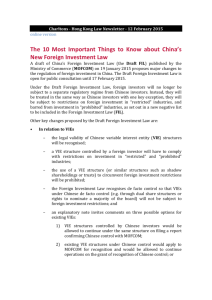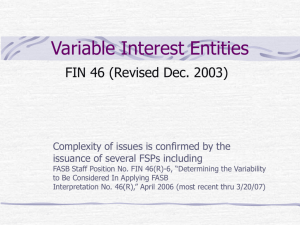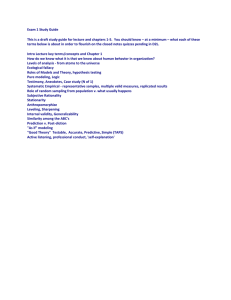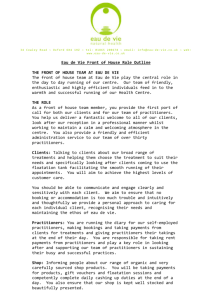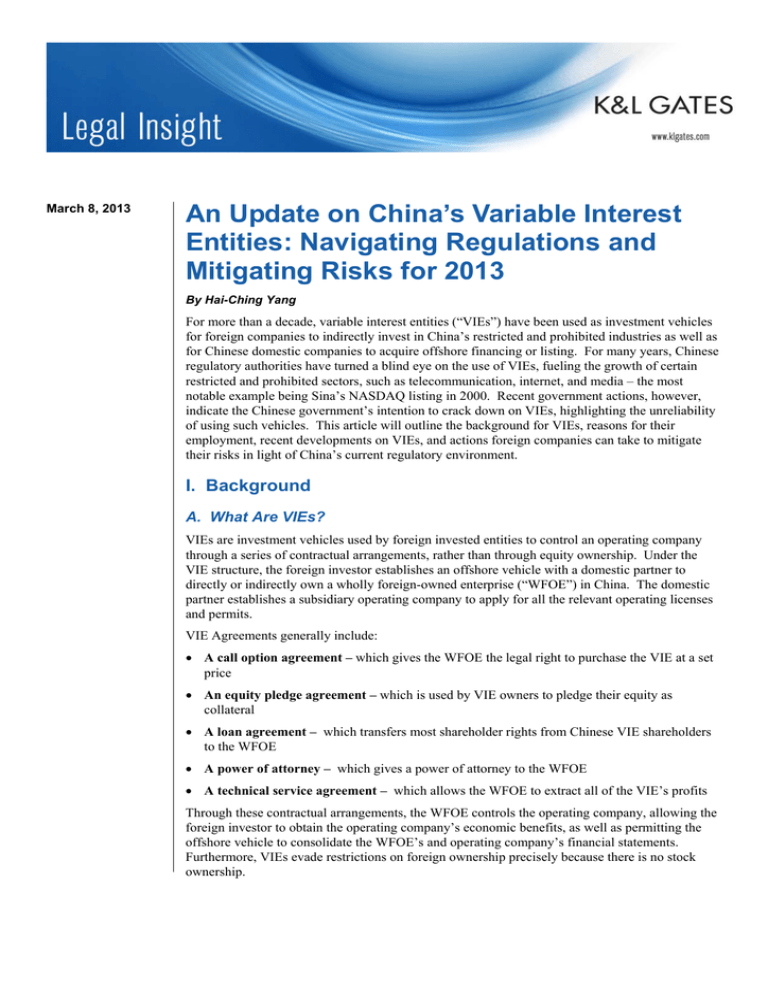
March 8, 2013
An Update on China’s Variable Interest
Entities: Navigating Regulations and
Mitigating Risks for 2013
By Hai-Ching Yang
For more than a decade, variable interest entities (“VIEs”) have been used as investment vehicles
for foreign companies to indirectly invest in China’s restricted and prohibited industries as well as
for Chinese domestic companies to acquire offshore financing or listing. For many years, Chinese
regulatory authorities have turned a blind eye on the use of VIEs, fueling the growth of certain
restricted and prohibited sectors, such as telecommunication, internet, and media – the most
notable example being Sina’s NASDAQ listing in 2000. Recent government actions, however,
indicate the Chinese government’s intention to crack down on VIEs, highlighting the unreliability
of using such vehicles. This article will outline the background for VIEs, reasons for their
employment, recent developments on VIEs, and actions foreign companies can take to mitigate
their risks in light of China’s current regulatory environment.
I. Background
A. What Are VIEs?
VIEs are investment vehicles used by foreign invested entities to control an operating company
through a series of contractual arrangements, rather than through equity ownership. Under the
VIE structure, the foreign investor establishes an offshore vehicle with a domestic partner to
directly or indirectly own a wholly foreign-owned enterprise (“WFOE”) in China. The domestic
partner establishes a subsidiary operating company to apply for all the relevant operating licenses
and permits.
VIE Agreements generally include:
A call option agreement – which gives the WFOE the legal right to purchase the VIE at a set
price
An equity pledge agreement – which is used by VIE owners to pledge their equity as
collateral
A loan agreement – which transfers most shareholder rights from Chinese VIE shareholders
to the WFOE
A power of attorney – which gives a power of attorney to the WFOE
A technical service agreement – which allows the WFOE to extract all of the VIE’s profits
Through these contractual arrangements, the WFOE controls the operating company, allowing the
foreign investor to obtain the operating company’s economic benefits, as well as permitting the
offshore vehicle to consolidate the WFOE’s and operating company’s financial statements.
Furthermore, VIEs evade restrictions on foreign ownership precisely because there is no stock
ownership.
An Update on China’s Variable Interest Entities:
Navigating Regulations and Mitigating Risks for 2013
B. Why Do Foreign Investors Use VIEs?
There are two main reasons why foreign investors use VIEs:
1. VIEs allow foreign investors to indirectly invest in restricted sectors.
Since the opening of China’s market, private companies in China have had difficulty in getting
access to capital and have looked to foreign investors as a source of funds. Unfortunately,
Chinese companies need permission to list overseas and foreign companies are restricted from
participating in certain domestic sectors. By necessity, VIEs are created to overcome these
challenges. VIEs allow foreign investors to reap the economic benefits of investing in a restricted
industry without having to obtain approvals for direct investment and permit domestic companies
to access capital in such restricted industries. Using the VIE structure, many Chinese internet
companies, including Sina, Baidu, Ctrip, Sohu, and Youku, have been able to list overseas.
2. VIEs circumvent the need to obtain approvals under M&A Rules for crossborder acquisitions.
People’s Republic of China Provisions on the Merger or Acquisition of Enterprises in China by
Foreign Investors (“M&A Rules”) provides that where a company, enterprise, or natural person in
China acquires an affiliated company in China in the name of its lawfully established or controlled
overseas company, examination and approval procedures must go through the Ministry of
Commerce of the People’s Republic of China (“MOFCOM”). Approvals for cross-border
affiliated acquisitions under the M&A Rules, however, are notoriously difficult to obtain. To
circumvent these rules, VIEs have been used to avoid having to obtain MOFCOM approvals, on
the basis that M&A Rules do not apply since VIEs do not involve any acquisition of a domestic
company by a foreign investor, nor involve direct equity transfer.
C. What Are the Risks of Using VIEs?
While VIEs seem to be a popular choice, they present a number of regulatory, legal, and business
risks.
1. Regulatory Risks
The main regulatory risk for VIEs is their lack of official approval from the Chinese authorities
and avoidance of Chinese regulatory supervision. Although VIE agreements do not allow their
foreign investors to directly own an equity stake in the operating company, the Chinese authorities
might view such indirect ownership as a foreign investment in a restricted sector without obtaining
all the necessary MOFCOM approvals. Investors have used VIEs to avoid restrictions from the
China Securities Regulatory Commission (“CSRC”) and to list on overseas securities exchanges.
Such action is problematic because Chinese authorities cannot exercise regulatory control over
such companies because they were formed in the Cayman Islands or other tax haven jurisdictions,
even though their substantive operations are in China. While companies seemed to have tacit
approval by government authorities in the past, they face risks that the authorities may require the
VIE structures to be unwound, depending on current government policies (see Part II).
2. Legal Risks – Enforceability of VIE Agreements
For foreign companies who use VIE structures to invest in restricted sectors, they face possible
risks that their contractual arrangements will not be respected by either the Chinese shareholder of
the VIE or by PRC courts. A feared scenario would be that the Chinese shareholder of the VIE
would take the VIE and refuse to acknowledge the VIE agreement. The VIE structure depends on
2
An Update on China’s Variable Interest Entities:
Navigating Regulations and Mitigating Risks for 2013
the enforceability of the contracts between the WFOE and the VIE – if those contracts are
breached, public shareholders would lose their investment in the VIE. The most famous example
highlighting this issue is the Yahoo-Alibaba (2010) case. In that case, the dispute arose when
Jack Ma, CEO of Alibaba transferred the ownership of Alipay (China’s leading online payment
processor) under a VIE structure to a domestic company controlled by Mr. Ma. Alipay was a
WFOE wholly owned by Alibaba Group, a Cayman Island company that was owned by Yahoo,
Softbank, and Mr. Ma. When People’s Bank of China regulators decided that Alipay could not
obtain the required license if the online payment company had foreign ownership (whether
through equity or VIE), this resulted in the dismantling of the VIE and Yahoo’s loss of Alipay.
Mr. Ma, on the other hand, obtained full ownership of Alipay. The Yahoo-Alibaba case serves as
a reminder that VIE agreements are not guaranteed to be enforceable.
3. Business Risks – PRC Shareholder Nominee for Foreign Companies
One of the main business risks that foreign companies face is the lack of trustworthy PRC
shareholder nominees for their operating companies. While domestic companies can find
trustworthy shareholder nominees for VIEs (e.g. through relatives or close friends), foreign
companies usually have difficulty securing PRC nominees due to lack of ties, which becomes
problematic if the partnership between the domestic company and foreign company dissolves.
II. Recent Developments (2009-2012)
Recent government actions also indicate a trend towards stricter regulation of VIEs.
Governmental and Legislative Actions against VIEs
1. Notice on Internet Games (2009)
In 2009, the State Commission Office for Public Sector Reform, along with two regulators,
published a notice on animation and internet games (“Notice”). The Notice states that foreign
investors may not control or participate in a domestic business that is engaged in online gaming by
entering into contractual arrangements, establishing a joint venture company, or offering technical
support. The Notice indicates Chinese authorities’ awareness of VIEs and their intention to
regulate the use of VIEs.
2. National Security Review (2011)
In 2011, MOFCOM issued provisions that banned the adoption of “control through contracts”
arrangements to evade national security review requirements for foreign investment in certain key
sectors that would otherwise be subject to review. The issuance of these provisions is a direct
attack by MOFCOM on VIEs since VIEs are known to use “control through contracts.”
3. CSRC Report (2011)
In 2011, CSRC purportedly issued a report that requested the State Council to push MOFCOM to
impose stricter regulations on the use of VIEs (especially in areas like the internet) and to
encourage Chinese companies to list at home. While the report is only “unofficial” and its
suggestions would require the collaborative efforts of multiple government agencies, it has led to a
decline in the price of companies using the VIE structure and signals stricter government control
on use of VIEs.
4. Circular 45 (2012)
In 2012, the CSRC issued a new circular on application for overseas listing by PRC enterprises
(“Circular 45”). Effective on January 1, 2013, Circular 45 states that joint stock companies
3
An Update on China’s Variable Interest Entities:
Navigating Regulations and Mitigating Risks for 2013
incorporated under the Company Law of the People's Republic of China that meet the listing
requirements effective in the intended regions may file applications with the CSRC for issuing
shares and listing overseas. CSRC, however, will reject an issuer's application if one of its
shareholders invested in the issuer through a VIE structure. Circular 45, though relaxes the
requirements for domestic enterprises to issue shares and list overseas, but also makes the VIE
structure more impracticable from commercial and legal perspectives.
III. Recommendations
With a trend towards stricter government control of VIEs and increasing risks for its use, foreign
companies can take several steps to mitigate their risks. First, foreign companies can “control the
chop.” This is important because the company chop definitively represents the company’s actions
and is needed to enter into contracts and to register for government approvals. By securing the
necessary company seals, the foreign company can retain control over its business in the operating
company in case of disputes. Second, foreign companies can install trusted persons at key
positions of the Chinese operating companies. While this is not a foolproof solution, such a move
would provide some security that there are personnel whose interest is solely for the foreign
companies. Lastly, foreign companies can shift their assets and businesses to the WFOE
whenever possible. Particularly for non-restricted sectors, foreign companies can expand their
businesses and acquire assets through the WFOE to ensure more direct ownership of the assets by
the foreign investor. By taking these precautions, foreign companies will be better prepared in
dealing with the risks and uncertainty surrounding VIEs.
Author:
Hai-Ching Yang
hai-ching.yang@klgates.com
+86.10.5817.6102
If you have any questions, please contact:
David Tang
david.tang@klgates.com
+86.10.5817.6000
Amy Sommers
amy.sommers@klgates.com
+86.21.2211.2085
Anchorage Austin Beijing Berlin Boston Brisbane Brussels Charleston Charlotte Chicago Dallas Doha Dubai Fort Worth Frankfurt
Harrisburg Hong Kong Houston London Los Angeles Melbourne Miami Milan Moscow Newark New York Orange County Palo Alto
Paris Perth Pittsburgh Portland Raleigh Research Triangle Park San Diego San Francisco São Paulo Seattle Seoul Shanghai
Singapore Spokane Sydney Taipei Tokyo Warsaw Washington, D.C.
K&L Gates practices out of 47 fully integrated offices located in the United States, Asia, Australia, Europe, the
Middle East and South America and represents leading global corporations, growth and middle-market
companies, capital markets participants and entrepreneurs in every major industry group as well as public
sector entities, educational institutions, philanthropic organizations and individuals. For more information
about K&L Gates or its locations, practices and registrations, visit www.klgates.com.
This publication is for informational purposes and does not contain or convey legal advice. The information herein should not be used or relied upon
in regard to any particular facts or circumstances without first consulting a lawyer.
©2013 K&L Gates LLP. All Rights Reserved.
4


